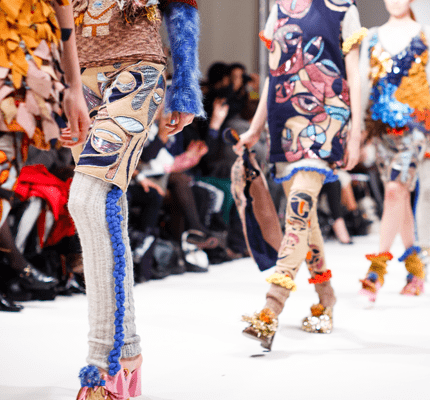
The Positive Impact of Plus-Sized Fashion Models on Women’s Body Image
Since the advent of fashion magazines, women have been comparing their bodies to those of models. In today’s era, it’s nearly impossible to avoid imagery of thin, scantily-clothed women – whether in magazines, on runways, television commercials, or in our social media feeds. And that, of course, leads to constant scrutiny and comparisons, which can potentially be detrimental to women’s mental and physical health.
It’s not surprising, then, that a new study in NCA’s Communication Monographs has found that women who view images of other women with similar and larger body types as their own report higher body satisfaction and fewer social comparisons. Researchers at Florida State University, including lead author Russell Clayton, Assistant Professor in the School of Communication; Jessica Ridgway, Assistant Professor in the Department of Retail, Merchandising and Product Development; and Joshua Hendrickse, doctoral student in the School of Communication, conducted an experiment in the School of Communication’s Cognition and Emotion Lab, examining 49 women’s responses to images of fashion models. Participants’ heart rates were recorded during image exposure, and they were asked questions about social comparisons and their own body satisfaction after viewing each image. The authors then proctored a visual recognition test after participants viewed the series of images to examine which models were most recognizable compared to similarly appearing models not shown during the experiment.
While there is growing awareness and advocacy within the fashion and beauty industry to design more clothing for plus-sized women and to promote body-positivity (such as Lane Bryant’s #ImNoAngel and Dove’s Real Beauty campaigns), the authors note that it is “unclear how such incorporations influence how women cognitively process these images, and the psychological benefits of viewing and comparing one’s self to fashion models with more realistic body types.” To address this, the study used the self-discrepancy theory, social comparison theory, and limited capacity model of motivated mediated message processing. Specifically, self-discrepancy theory allowed the researchers to understand which models represented the participants’ ideal self. By knowing the participant’s ideal body type, the researchers were then able to make predictions pertaining to which models would result in the greatest or least social comparisons. The Limited Capacity Model of Motivated Mediated Message Processing (LC4MP) guided the authors’ predictions pertaining to how engaging in social comparisons would influence women’s real-time attention and subsequent performance on the visual recognition task.

The Theories at Work
Participants in this study considered themselves to be at “normal weight” body type/size, but all wished to be thinner, resulting in an actual-ideal self-discrepancy, which is associated with dejection-related affect, such as decreased body satisfaction. So, when the researchers showed thin models, it was expected that there would be less reported body satisfaction. It was also expected that the participants would experience enhanced body satisfaction when presented with models whose bodies were closer to the participants’ actual self. The researchers found this hypothesis to be supported. Body satisfaction was less when thin models, who represented participants’ ideal body size, were shown, but body satisfaction increased when models who appeared similar in size (average and plus size) were shown.
Yet another framework the researchers used for their study is social comparison theory, which posits that “individuals learn about themselves consciously and automatically by comparing their own traits and abilities with those of other people.” The authors found that greater social comparisons occurred when participants viewed a model who represented their ideal self (thinner). Fewer social comparisons occurred when participants viewed models who were furthest from the participants’ ideal body shape—that is, the average and plus size models.
The final theory at work in this study is an information-processing model, which says that audience members exposed to media messages have a “limited capacity of mental resources that can be used to consciously and unconsciously encode, store, and retrieve information.” The participants’ heart rate recordings were used to index resources allocated to encoding content (attention). The researchers were specifically interested in assessing how social comparisons, a type of internal processing, influence women’s resources allocation to encoding and remembering content. The findings indicated that when participants viewed plus-size models, their heart rates decelerated, indicating they allocated greater resources to encoding (greater attention) plus-size models followed by average-size models. Participants’ heart rate decelerated the least when thin size models were shown, indicating less attention. The researchers also found plus-size models to be recognized more accurately, followed by average and thin size models. The researchers surmise that engaging in social comparisons during exposure to thin models reduced the amount of cognitive resources that could be allocated to encoding and storing the thin models into memory. This interpretation becomes stronger, because as social comparisons decreased with average- and plus-size models, resources allocated to encoding and storing the models into memory increased.
Implications for Fashion Industry
The authors’ results suggest that exposure to images of one’s ideal body type (thin models) leads to the greatest amount of dejection-related emotions, and the least amount of body satisfaction. Conversely, exposure to images of models that are similar to one’s actual body type results in higher satisfaction and fewer social comparisons. Clayton and his colleagues note that there is a “clear psychological advantage of depicting the non-ideal body type in media campaigns.” Additionally, portraying more average and plus-size models “might be a useful persuasive strategy if the goal of a campaign is to increase attention to and memory of a media message.”



